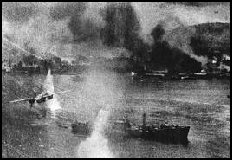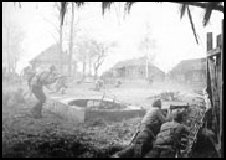 US aircraft hit Japanese shipping at Rabaul |
Project 60: A Day-by-Day Diary of WWII
Remembering the First Fight Against Fascism |
 Red Army infantry liberate another village on the long road to Berlin |
 US aircraft hit Japanese shipping at Rabaul |
Project 60: A Day-by-Day Diary of WWII
Remembering the First Fight Against Fascism |
 Red Army infantry liberate another village on the long road to Berlin |
The 2nd Ukrainian Front
under Konev launches fresh attacks out of the Kremenchug area. Italian Marines from the San Marco,
now fighting for the Allies, are the first troops to enter Venice. Soviet forces meet determined
resistance from von Manstein's Army Group south. The attacks are stopped cold
with heavy losses. The Allies announce that they will
establish a war crimes tribunal under the auspices of the UN after hostilities
are concluded. SS troops surrounded the Minsk ghetto
for one last time. 2000 Jews were loaded into trucks and taken away to be shot.
The buildings were blown up, just in case someone was hiding in them. The last
inhabitants of the ghetto perished on this last day of the tragedy. Only the
ruins would bare witness to the horrible and inhuman crimes committed against
the tens of thousands of Jews of the Minsk Ghetto. Continuing with their near nightly terror bombing of German cities, RAF Bomber command hits the city of Kessel in a particularly devastating raid. 569 bombers, all of them four engine heavy Lancasters or Halifax bombers. Despite initial errors in marking the center of town, the raid was remarkably concentrated and accurate. The combination of high explosives and incendiary bombs created a firestorm smaller but reminiscent of the one in Hamburg in July. Over 11,000 blocks of housing were destroyed or heavily damaged displacing over 100,000 people. 5,600 people were killed and another 2,800 were missing and presumed dead. The three Henschel aircraft plants were seriously damaged and this set back the production of V-1 bombs. The daily murder of people at Aushwitz
was interrupted when one woman, among the 1750 Polish Jews that arrived that
day, rebelled. When ordered to strip, she threw her shoe at SS Sergeant-major
Josef Schillinger. In the ensuing confusion, she took his pistol and shot him in
the stomach, mortally wounding him, and wounded a second SS sergeant. This set
off a riot among the rest of the women in line outside the gas chamber. One SS
trooper had his nose ripped off and a second SS soldier was scalped. The
women's victory was short lived. The camp commander, Rudolf Hoess, organized a
counter attack and sprayed the area down with machine pistols and grenades. The
survivors were shot. After 10 days of heavy street fighting,
Soviet forces take Melitopol. Dnepropetrovsk also falls as tank spearheads reach
Krivoi Rog. German E-boats attack a convoy off
Norfolk sinking one trawler for the cost of three of their craft. The Japanese open the infamous Siam-Burma rail line (of "Bridge on the River Kwai" fame). Of the 46,000 Allied POWs forced to labor on the project, 16,000 would die of starvations, brutality and illness. RAF bomber command hits Stuttgart while the US 8th Air Force launches a devastating attack against Bremen. Field Marshal von Kluge is invalided
and removed from command of Army Group Center after he is severely injured in a
car crash. The 2nd Marine Parachute Battalion makes a diversionary sea borne assault at Voza on Choiseul Island in support of the main operations to commence against Bougainville. Red Army attacks against the German 4th
Army between Orsha and Vitebsk intensify. The hard pressed Germans contain the
Soviet advances in heavy fighting. The US 5th Army captures
Mondragone, Italy Soviet forces capture Genichesk, cutting the only rail communications for the Germans into the Crimean peninsula. The Italian 1st Motorized Group became the first large Italian formation to fight with the Allies. They were assigned to the 5th Army. Soviet forces capture Chaplinka,
sealing off the Crimean peninsula from land communications, trapping the German
17th Army. The German's only line of communications is across the
Black Sea to Rumania. Red Navy forces land on the Kerch peninsula. The US 3rd Marine Division
lands 14,000 troops at Cape Torokina, opening direct operations against
Bougainville. The landings are supported by 4 cruisers and 8 destroyers from TF
39 and air support comes from the carriers Saratoga and Princeton (TF 38)
The landings are resisted fiercely and the marines are subjected to heavy aerial
attacks. 1941 Archive: 1942 Archive: 1943 Archive: Special Editions: Editor's Corner Archive: Hitler's Angel "The story of Prescott Bush and his association with the Nazis begins just before the end of World War I..." The Past Through Tomorrow "It is quite frightening to realize just how similar our nation's actions have been and appear to be heading when compared this way..." Afghanistan and Vietnam: When the "war against terrorism" began, many knowledgeable people warned that our operations in Afghanistan would turn into another Vietnam. Want to Win - Think Before You Lash Out - "If we are serious about taking the war to the enemy, it is time to look ..." The First Fight Against Fascism - We must remember the Spanish Civil War also. Arguing Victory - "... Each nation who fought against fascist tyranny in WWII brought with it part of whole needed to defeat that evil..." War, Glory, Honor and Remembrance - "War is a brutal and savage insult on human society..." The First
Casualty... in time of war, those in power are even more inclined to
hide the truth, since that truth is often manifest in the most gruesome and
terrible acts. Those wishing to contribute items. stories or comments should contact D.A. Friedrichs |